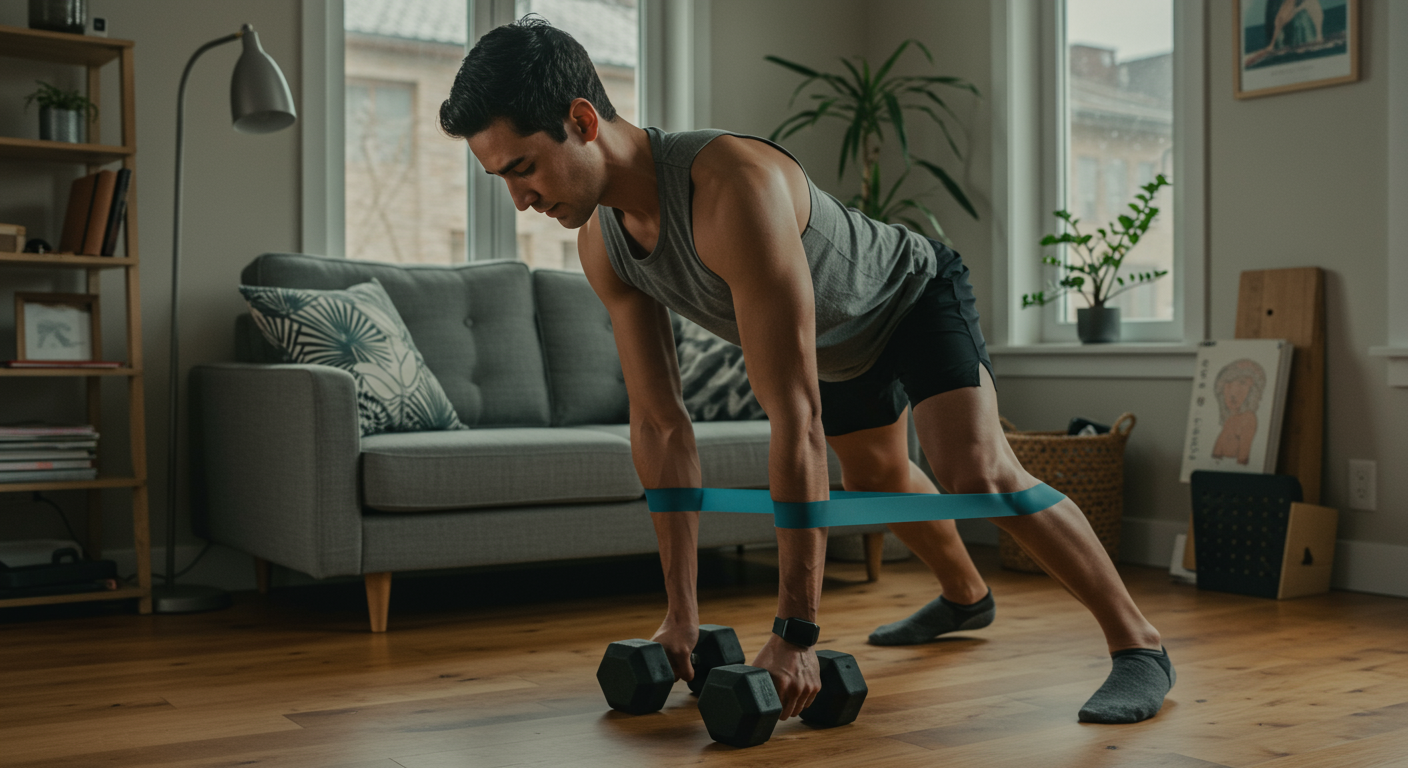Are you ready to take your home workouts to the next level? This guide is designed for fitness enthusiasts looking to build muscle and increase strength using dumbbells. Whether you're short on time or space, we'll show you how to maximize your results with a 30-minute full-body dumbbell workout.

Mastering Key Techniques for This Workout
Before diving into the workout, let's review the key techniques to ensure you're performing each exercise safely and effectively.
- Proper Form: Focus on maintaining correct form throughout each exercise. This is more important than lifting heavy weights. Watch videos, and if possible, have someone check your form, especially when starting.
- Controlled Movements: Perform each rep with control. Avoid jerky motions and focus on the muscle contractions.
- Breathing: Inhale during the eccentric (lowering) phase and exhale during the concentric (lifting) phase. Proper breathing helps maintain energy and stability.
- Progressive Overload: Gradually increase the weight, reps, or sets as you get stronger. This is crucial for muscle growth.
Advanced Variations and Progressions
Once you're comfortable with the basic exercises, you can incorporate advanced variations to challenge your muscles further.
- Tempo: Vary the tempo of your reps (e.g., slow eccentric phase, pause at the top) to increase time under tension.
- Drop Sets: Perform a set to failure, then immediately reduce the weight and continue for more reps.
- Supersets: Combine two exercises back-to-back with no rest for an extra challenge.
- Unilateral Exercises: Perform exercises one limb at a time (e.g., single-leg deadlifts) to improve balance and target specific muscle groups.
Step-by-Step Instructions (detailed, with pro tips)
Here's a sample 30-minute full-body dumbbell workout. Remember to warm up before and cool down after each workout.
- Warm-up (5 minutes): Dynamic stretching such as arm circles, leg swings, torso twists, and high knees.
- Workout (20 minutes):
- Dumbbell Squats: 3 sets of 8-12 reps. Pro Tip: Keep your back straight, chest up, and core engaged.
- Dumbbell Chest Press: 3 sets of 8-12 reps. Pro Tip: Keep your elbows at a 45-degree angle to your body.
- Dumbbell Rows: 3 sets of 8-12 reps per side. Pro Tip: Squeeze your shoulder blades together at the top of each row.
- Overhead Press: 3 sets of 8-12 reps. Pro Tip: Engage your core to maintain stability.
- Dumbbell Deadlifts: 1 set of 5 reps, 1 set of 3 reps, 1 set of 1 rep. Pro Tip: Keep the bar close to your legs.
- Cool-down (5 minutes): Static stretching, holding each stretch for 30 seconds. Focus on the muscles worked.
Maximizing Your Results at Home
To make the most of your home workouts, consider these key factors:
- Equipment: While this workout uses dumbbells, consider using a yoga mat or resistance bands for warmups. If you need an adjustable dumbbell set, check out Bowflex Adjustable Dumbbells, which save space and offer a wide range of weights.
- Nutrition: Fuel your body with a balanced diet that supports muscle growth and recovery. Consume enough protein, carbohydrates, and healthy fats.
- Rest: Get adequate sleep (7-9 hours) to allow your muscles to recover and rebuild.
- Consistency: Aim for at least 2-3 strength training sessions per week.
Advanced Training Principles
Beyond the basics, consider these advanced training principles to continually challenge your muscles:
- Periodization: Vary your training volume and intensity over time to prevent plateaus.
- Deload Weeks: Incorporate a deload week every 4-6 weeks to allow your body to recover fully.
- Mind-Muscle Connection: Focus on the muscle you're working during each exercise. This can improve muscle fiber recruitment.
Integrating with Your Existing Routine
This full-body dumbbell workout can be integrated into various fitness routines:
- Supplement to Cardio: Combine with cardio exercises (running, cycling, etc.) for a well-rounded fitness plan.
- Add to Your Current Routine: If you are already working out, add these exercises in for a couple of days during the week.
- Workout Schedule: Alternate this workout with other types of exercise, such as yoga or cardio.
Pushing Your Limits Safely
- Listen to Your Body: Take rest days when needed, and don't push through pain.
- Proper Warm-up: Always warm up before each workout to prepare your muscles.
- Cool-down: Cool down and stretch your muscles after each workout to improve flexibility.
Expert-Level Home Fitness Insights
- Invest in Quality: Consider investing in quality dumbbells and other equipment that will last.
- Create a Dedicated Space: If possible, set up a dedicated workout space at home.
- Track Your Progress: Keep a workout log to track your progress and stay motivated.